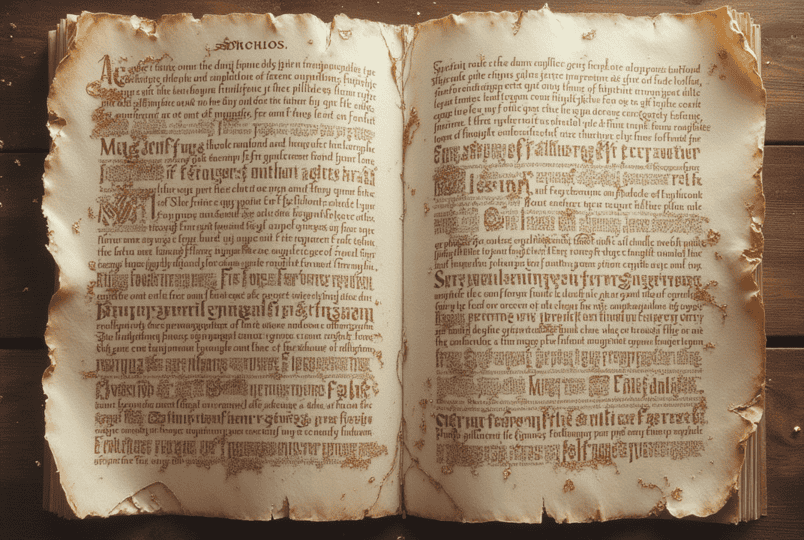As the Christian church developed, its leaders became careful about what texts from the scripture they should consider authoritative.
Eventually, some were deemed “apocryphal” and kept out of the official Bible.
They often contained ideas that challenged church doctrines or presented alternative views on Christ or salvation.
They were seen as dangerous or heretical, so church leaders moved to suppress them.
We’re going to explore 9 of these apocryphal texts and see what about them seemed to threaten the church doctrine.
1. The Book of Enoch
The Book of Enoch is a massive collection of angelic visions, apocalyptic prophecies, and teachings of Noah’s great-grandfather, Enoch.
It describes fallen angels, called Watchers, who descend to Earth and corrupt humanity. They teach forbidden knowledge to humans, leading to chaos and evil.
The book emphasizes the cosmic battle between good and evil, and the origin of sin.
Though it was popular in some early Christian circles, the Book of Enoch was eventually removed from the Bible.
It was excluded mainly because it contained a detailed description of angels and apocalyptic themes that clashed with the doctrine and caused confusion.
It was banned by the 4th century, but still remained relevant in some circles.
2. The Gospel of Thomas
This collection of 114 sayings attributed to Jesus is quite different from the canonical Gospels.
It emphasizes the importance of personal spirituality over church hierarchy and rituals.
Many of them urge followers to look within themselves and understand the kingdom of God privately.
The church, of course, couldn’t leave this text in the Bible because it undermined its authority and challenged orthodox teachings about salvation and faith.
It was also considered heretical because it promoted a Gnostic idea that salvation came through inner knowledge.
3. The Gospel of Mary Magdalene
This text elevates Mary Magdalene as a key disciple and spiritual teacher, not just a follower.
It suggests she received secret teachings from Jesus and was the person He trusted most. Mary Magdalene was one of the apostles.
The church leaders, however, saw Mary’s prominence as problematic, as its hierarchy was male-dominated.
The Gospel of Mary was likely written in the 2nd century, but it was lost for hundreds of years until its discovery in the 19th century.
The suppression of this gospel from the Bible was part of the broader effort to marginalize women’s authority in religious circles.
By promoting male apostles and leaders, it aimed to solidify its patriarchal control.
4. The Apocalypse of Peter
This fiery apocalyptic text vividly depicts what happens to sinners in the afterlife, with graphic punishments in hell.
It was very popular in the early church because it reinforced the idea of divine justice.
However, these graphic descriptions and some theological themes clashed with the evolving doctrine.
The Apocalypse of Peter was eventually rejected by church authorities and excluded from the Bible by the 4th century because it was seen as too sensational.
Despite its popularity among believers, church leaders feared it might incite fear and heresy.
Today, it survives in fragments and copies outside the official canon.
5. The Infancy Gospel of James
This text focuses on the birth and childhood of the Virgin Mary, emphasizing her purity and divine origins.
It presents her as sinless and chosen by God from birth. It also describes the miraculous birth of Jesus.
While popular in some early Christian communities, it was considered apocryphal because it contained legendary elements that weren’t backed by official church teachings.
Its focus on Mary’s divine nature also created confusion and clashed with the church’s understanding of Jesus’s human and divine duality.
The church officially excluded it from the Bible by the 4th century.
6. The Acts of Paul and Thecla
The story depicts Paul’s encounter with Thecla, a woman who becomes a devoted follower and teacher, defying social norms.
Thecla’s focus on celibacy and her spiritual authority once again challenged traditional gender norms and church hierarchy.
The story was popular among some early Christians but was controversial for promoting women’s leadership and independence.
The church saw this as potentially destabilizing to authority structures.
It was likely banned from the Bible in the 4th century as part of the effort to consolidate official teachings.
7. The Gospel of Judas
This Gnostic gospel portrays Judas Iscariot not as a traitor but as acting on Jesus’s instructions, revealing a different understanding of betrayal.
It suggests that Christ actually trusted Judas, challenging the view of Judas as the traitor.
Discovered in the 1960s and published in 2006, it was considered heretical because it undermined the idea of Jesus’s sacrifice.
The church decided to keep it out of the Bible in order to uphold the significance of Jesus’s death.
It was essentially banned from the canon because it conflicted with core doctrines of the faith.
8. The Shepherd of Hermas
Questo allegorical text was widely read in the early church, offering moral lessons about repentance, humility, and faith.
However, it was ultimately excluded from the Bible because it was seen as apostolic or authoritative enough.
The Shepherd of Hermas was written in the 2nd century and reveals early Christian ethics more than theology.
Church authorities later classified it as apocryphal, fearing its allegories could be interpretato male or undermine the church hierarchy.
By the 4th century, the doctrine became more standardized, which was when this text was banned.
9. The Apocalypse of Baruch
This apocalyptic text, attributed to Jeremiah’s scribe, Baruch, describes visions of the end times, divine justice, and the afterlife.
It explores themes of sofferenza and the hope of salvezza.
It contains controversial elements, like detailed depictions of heaven and hell, which sometimes conflict with the doctrine.
The church considered some parts of it too speculative and maybe even heretical.
It was also excluded from the Bible by the 4th century, mainly because it wasn’t focused on Jesus Christ.
A little Aquarius, devoted to writing and embroidery. Through my writing, I hope to empower readers to align with their true selves and navigate life’s mysteries with confidence.










